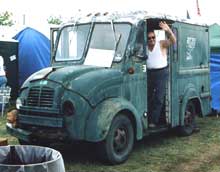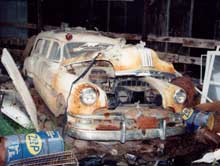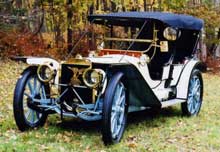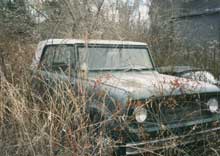Got Milk?
We lived in farming country when I was growing up, so getting milk was but a short walk across the lane. My first experience with milk delivery came the summer I turned eight, when we went to Cape Cod. Our cottage colony was served by competing dairies, H.P. Hood & Son and White Brothers. Milk, eggs and cream came in little snub-nose milk trucks called Divcos, whose operators drove most of their routes while standing. I was transfixed.
I'd never heard of Divco. Eventually I learned it was an acronym for Detroit Industrial Vehicle Company, formed in Detroit in 1926. Divco's objective was to produce a truck as versatile and maneuverable as a horse-drawn milk wagon, according to designs of George Bacon. Bacon's concept used electric propulsion, but very quickly Divco moved to gasoline power. Early Divcos included the 1929 Model G, which could be driven from either the left or right step.
The archetypal Divco, the Model U, arrived in 1937. An upright box with a snub nose to house the engine, the U and its successors would be an icon for home delivery until the 1980s. Drive trains varied, with four- and six-cylinder engines from Continental, Hercules, Ford, Nash, Perkins and Detroit Diesel; gasoline and diesel fueled, overhead valve and L-head, driving through three- and four-speed transmissions. The cargo area was configured to hold milk crates securely, and refrigeration was provided with ice. Divcos left a trail of water wherever they went.
The key fascination for a young man, one yearning to drive and experimenting with every vehicle he could get his hands and feet on, was the way the milk men (I remember no milk maids or milk ladies) deftly maneuvered their Divcos while standing. I spent many hours trying to figure out how it was done.
John Rienzo of the active and enthusiastic Divco Club of America, explains: "There are several drive combinations and brake options: sit drive, as in any vehicle; stand drive; or combination stand and sit drive. When you sit drive in the combination truck, you use the standard pedals on the toe board, clutch, brake and gas. You shift with the steering column mounted shift lever. The long lever that you see to the right of the steering wheel is a "snubber brake" that is used to slow the truck. It actuates the hydraulic brake system at the wheels. This is an option and was on the left side of the steering wheel in earlier models.
"When you stand drive, the pedal on the kick panel is both the clutch and brake. Halfway down is the clutch and the brake is all the way down. There is also a ratchet dog that locks the brake down. This is why you need to use the snubber brake to slow the vehicle. Since you cannot use your left foot on the clutch/brake and the right foot on the gas at the same time (small round pedal on the floor that you can use as the gas when you are stand driving but not shifting) the column shift lever has a stippled grip that allows you to shift using a normal pattern and twist the shift handle which controls the gas.
"That is the basic operation, but there are several slightly different combinations based on the options, model and year." I can only imagine the instinctive reactions that one would have to learn to drive a Divco like a pro.
Divcos are, as the saying goes, "America's favorite milk truck," despite the fact that most home delivery of milk ceased decades ago. Jim Merrick discovered this one at the Windsor (Maine) Fair a couple of years ago; it reminded him of his late uncle who used to drive one for this same dairy. The 2006 AACA show at Hershey was well attended by Divcos, including a Twin Coach, for a time twinned with Divco. There's an excellent book on Divco, which John Rienzo co-authored with Robert Ebert, available from the publisher.
Well, now that I understand how those mysterious controls work, I want to try them myself. Who'll teach me to drive a Divco?




